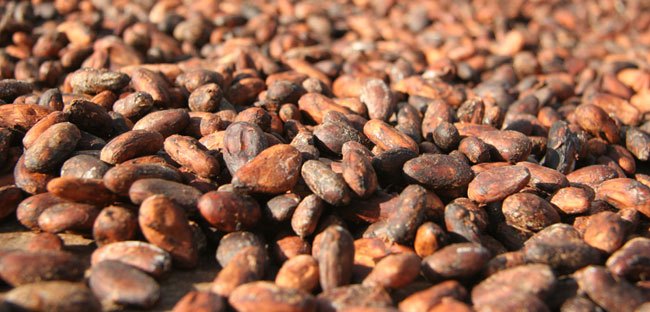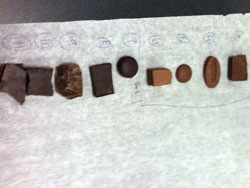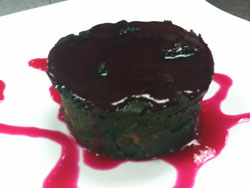
© 2003 Fairtrade Foundation
Chocolate Weeks One and Two
I’m combining the notes from the Bakeshop Skill Class for the first two weeks covering Chocolate, I’ll do the same for the next two weeks as well. Due to the weather, the class schedule has been changed slightly (it was 100°F yesterday so we could not temper chocolate, it was too hot). The two weeks were spent covering chocolate basics, including tasting and tempering and creating a few chocolate-based desserts.
We started off the lecture by watching a short film on the history and process of chocolate making. Chocolate is produced from the seed of the Theobroma cacao tree. Cacao has been cultivated for at least three thousand years in South America. The majority of the Mesoamerican people made chocolate beverages. The seeds of the cacao tree have a bitter taste and must be fermented to develop the flavor. After fermentation, the beans are dried, cleaned, and roasted, and the shell is removed to produce cacao nibs. The nibs are then ground to cocoa mass, the longer it is ground the smoother it becomes. This process is called conching. At this point, the chocolate can be processed into cocoa solids and cocoa butter.
When making decorations or candy out of chocolate the chocolate must first be tempered. This is done to ensure that the finished product is hard, snaps when broken shows no signs of bloom (cocoa mass that comes to the surface) and won’t melt on your fingers/hands. There is a lot of science involved in Chocolate, if your interested in reading more in-depth about it I recommend this article.
Tempering is accomplished in three stages: melting, cooling and warming. It is vital that a probe thermometer is used as a candy thermometer will not work. When tempering remove from heat about 5°F bellow desired temperature because it continues to heat once removed from the heat source. Use a metal bowl because glass holds heat longer and takes longer to cool down.
Dark
melting 115°F – 118°F
cooling 82°F – 65°F
warming 89°F – 91°F
Milk/White
melting 113°F – 115°F
cooling 78°F – 82°F
warming 87°F – 89°F
There are three main cooling methods. With the seed method, small pieces of room temperature chocolate are added to cool the chocolate to the desired temperature. The block method uses a solid mass of chocolate to accomplish this. The benefit is you do not have to remove multiple pieces of chocolate from the cooled chocolate if the desired temperature is reached before the multiple pieces melt. The third method is tabling or poring the heated chocolate on a marble slab.
There are two main types of chocolate used in decorating and candy. Coverture is cocoa liquor, sugar, cocoa butter, vanilla, and emulsifier. Coating Chocolate is cocoa liquor, sugar, hydrogenated oil, vanilla, emulsifier. Coating Chocolate does not have to be tempered since because the hydrogenated oil solidifies. However, the flavor and mouthfeel will suffer. Real white chocolate is not white, it has a yellow cast/ivory color from the cocoa butter.
Mexican Chocolate is coarse and grainy. It’s not conched very long and is therefore cheaper. It contains sugar, cinnamon, and cocoa. It’s all ground together with raw ingredients. Oaxacan Chocolate adds almonds to the chocolate. All varieties are made for cooking and drinking, not meant as eating chocolate.
Heres what we made/did:
 Chocolate Tasting
Chocolate Tasting Chocolate Transfer Demonstration
Chocolate Transfer Demonstration Oaxacan Chocolate Bread Pudding with Tuna (Prickly Pear) Sauce
Oaxacan Chocolate Bread Pudding with Tuna (Prickly Pear) Sauce